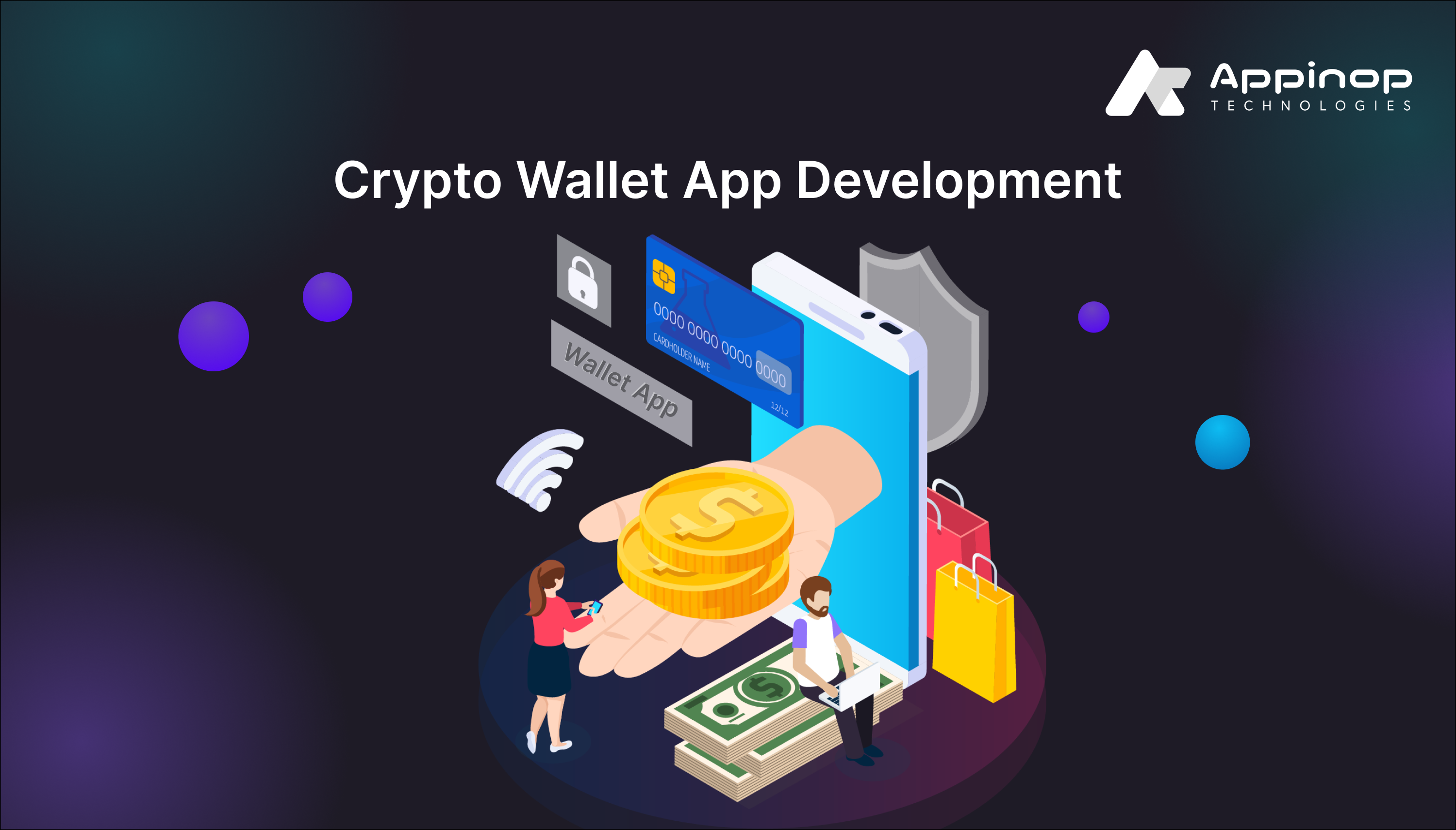
Crypto Wallet App Development: Complete Process 2024
Cryptocurrencies have emerged as a revolutionary force in the financial world, reshaping how we perceive and handle transactions. As digital currencies like Bitcoin, Ethereum, and countless others gain mainstream acceptance, the need for secure and efficient crypto wallets has never been greater. A crypto wallet is not just a digital tool for storing cryptocurrencies; it’s a gateway to the decentralized financial ecosystem, enabling users to manage their assets, perform transactions, and interact with various blockchain-based applications.
In 2024, the landscape of crypto wallet app development has become increasingly sophisticated. Developers are integrating advanced security features, user-friendly interfaces, and seamless multi-currency support to cater to the diverse needs of users. This blog aims to provide an in-depth guide to the complete process of developing a crypto wallet app, from the initial planning stages to deployment and maintenance.
We’ll explore the intricacies of crypto wallet development, the time and costs involved, and the benefits of choosing professional development services. Whether you are a business looking to offer a crypto wallet to your customers or an individual interested in understanding the process, this guide will equip you with the knowledge needed to navigate the world of crypto wallet App development.
What is Crypto Wallet App Development?

Crypto wallet app development refers to the creation of digital applications that allow users to store, manage, and transact their cryptocurrencies securely. These wallets can be classified into different types based on their functionality and storage methods, such as hot wallets (online) and cold wallets (offline). The development process involves integrating security protocols, ensuring compatibility with various cryptocurrencies, and creating a seamless user experience.
1. Hot Wallets: These are online wallets accessible via the internet, offering convenience and ease of use. Examples include web wallets and mobile wallets.
2. Cold Wallets: These are offline wallets that provide enhanced security by being disconnected from the internet. Examples include hardware wallets and paper wallets.
Key Features of Crypto Wallets:
1. Multi-Currency Support: Ability to store and manage various cryptocurrencies like Bitcoin, Ethereum, and others.
2. Security Protocols: Encryption, two-factor authentication (2FA), and biometric verification.
3. User Interface (UI): An intuitive and easy-to-navigate design.
4. Transaction History: Detailed records of all transactions.
5. Integration with Exchanges: Ability to buy, sell, and trade cryptocurrencies directly from the wallet.
The Crypto Wallet App Development Process

1. Requirement Analysis and Planning
The initial phase involves understanding the client’s requirements, target audience, and desired features. This includes deciding the type of crypto wallet app development, supported cryptocurrencies, and functionalities such as:
Multi-Signature Support: Enhances security by requiring multiple approvals for transactions.
In-App Cryptocurrency Exchange: Allows users to trade cryptocurrencies within the wallet.
Payment Gateway Integration: Enables transactions for purchasing goods and services.
2. Design and Prototyping
In this phase, designers create wireframes and prototypes to visualize the app’s layout and user journey. Key aspects include:
User Experience (UX): Ensuring the app is user-friendly and intuitive.
User Interface (UI): Designing visually appealing and easy-to-navigate interfaces.
Responsive Design: Ensuring the app works seamlessly across various devices and screen sizes.
3. Development
The development phase involves coding the frontend and backend of the wallet app. Key components include:
Blockchain Integration: Connecting the wallet to multiple blockchain networks for seamless transactions.
Security Features: Implementing encryption, 2FA, biometric verification, and other security protocols.
API Integration: Integrating with third-party services like cryptocurrency exchanges, market data providers, and payment gateways.
4. Testing
Extensive testing is conducted to ensure the app is secure, functional, and user-friendly. Testing includes:
Unit Testing: Checking individual components for functionality.
Integration Testing: Ensuring different components work together seamlessly.
Security Testing: Identifying and fixing vulnerabilities.
User Acceptance Testing (UAT): Gathering feedback from real users to improve the app.
5. Deployment
Once the app passes all tests, it is deployed to the respective app stores (Google Play Store, Apple App Store) or made available for download from the developer’s website. This involves:
Setting Up Hosting and Servers: Ensuring the app’s backend infrastructure is robust and scalable.
Publishing on App Stores: Complying with app store guidelines and submitting the app for approval.
6. Maintenance and Updates
Post-deployment, the app requires regular maintenance to ensure it remains secure and functional. This includes:
Bug Fixes: Addressing any issues reported by users.
Security Updates: Keeping the app’s security protocols up-to-date.
Feature Enhancements: Adding new features based on user feedback and market trends.
How Long Does It Take to Develop a Crypto Wallet?

The timeline for developing a crypto wallet can vary significantly based on several factors, including the complexity of the project, the number of features required, and the development team’s expertise. Here’s a more detailed breakdown of the development timeline:
1. Basic Wallet: 3 to 6 months
2. Advanced Wallet with Additional Features: 6 to 12 months or longer
Factors Influencing Development Time:
1. Feature Complexity: More features and functionalities require more development time.
2. Security Requirements: Higher security measures extend the timeline.
3. Blockchain Integration: Integrating with multiple blockchains can be complex and time-consuming.
4. Testing and Quality Assurance: Rigorous testing to ensure the app’s reliability and security.
How Much Does Crypto Wallet App Development Cost?

The cost of developing a crypto wallet can vary significantly based on a range of factors, including the wallet’s complexity, desired features, security requirements, and the expertise of the development team. Here’s a detailed breakdown of the potential costs involved in building a crypto wallet:
1. Basic Wallet Features
Developing a crypto wallet with fundamental features such as storage, transaction management, and basic security measures generally costs between $30,000 and $50,000. This includes:
Core Functionality: Managing transactions, viewing balance, and generating addresses.
Basic Security Measures: Encryption and single-factor authentication.
UI/UX Design: Standard design for ease of use.
2. Advanced Features
For wallets with advanced functionalities like multi-currency support, in-app trading, or enhanced security measures, costs can range from $50,000 to $100,000. Additional features might include:
Multi-Currency Support: Handling various cryptocurrencies with seamless integration.
In-App Exchange: Enabling users to buy, sell, or trade cryptocurrencies within the app.
Advanced Security Features: Multi-signature support and biometric authentication.
3. High-Level Security
Implementing advanced security protocols to protect against sophisticated attacks can add $20,000 to $40,000 to the development cost. This includes:
Advanced Encryption: High-grade encryption methods for secure transactions and storage.
Two-Factor Authentication (2FA): Extra layer of security for user accounts.
Regular Security Audits: Ongoing assessments to identify and mitigate vulnerabilities.
4. Multi-Currency Support
Adding support for a wide range of cryptocurrencies can cost between $10,000 and $30,000. This involves:
Blockchain Integration: Connecting with various blockchain networks.
Wallet Management: Implementing features to handle multiple assets efficiently.
Transaction Compatibility: Ensuring seamless transactions across different currencies.
5. UI/UX Design
Investing in high-quality UI/UX design typically costs between $10,000 and $20,000. This encompasses:
Custom Design: Tailoring the interface to enhance user experience and engagement.
Responsive Design: Ensuring the wallet functions well across different devices and screen sizes.
User Testing: Conducting usability testing to refine the design.
6. Integration with Exchanges
Integrating the wallet with cryptocurrency exchanges can add $10,000 to $30,000 to the overall cost. This includes:
API Integration: Connecting with exchange APIs for trading and market data.
Transaction Processing: Handling exchange transactions within the app.
Compliance and Security: Ensuring integration meets regulatory and security standards.
7. Testing and Quality Assurance
The cost for comprehensive testing and quality assurance ranges from $10,000 to $20,000. This covers:
Unit Testing: Testing individual components for functionality.
Integration Testing: Ensuring all components work together smoothly.
Security Testing: Identifying and addressing potential security issues.
8. Maintenance and Updates
Post-launch maintenance and updates typically cost between $5,000 and $10,000 per year. This includes:
Bug Fixes: Resolving issues reported by users.
Security Patches: Applying updates to address new vulnerabilities.
Feature Enhancements: Adding new functionalities based on user feedback.
Factors Influencing the Cost
Several factors can impact the overall cost of developing a crypto wallet, including:
Development Team Location: Costs can vary based on the geographical location of the development team. For example, teams in North America or Western Europe generally charge more than those in Eastern Europe or Asia.
Project Complexity: More complex projects with additional features and integrations will cost more.
Security Requirements: High-level security measures can significantly increase development costs.
Design Requirements: Custom and intricate designs can add to the cost.
| Sr. | Factor | Estimated Cost (USD) |
| 1 | Basic Wallet Features | $30,000 – $50,000 |
| 2 | Advanced Features | $50,000 – $100,000 |
| 3 | High-Level Security | $20,000 – $40,000 |
| 4 | Multi-Currency Support | $10,000 – $20,00 |
| 5 | UI/UX Design | $10,000 – $20,000 |
| 6 | Integration with Exchanges | $10,000 – $30,000 |
| 7 | Testing and QA | $10,000 – $20,000 |
| 8 | Maintenance and Updates | $5,000 – $10,000/year |
Benefits Offered by Our Crypto Wallet App Development Services

1. Security
We prioritize security, implementing cutting-edge encryption techniques, two-factor authentication, and biometric verification to protect user assets. Our wallets undergo rigorous security audits to ensure the highest level of protection against threats.
2. Customization
Our development services offer extensive customization options to meet your specific needs. Whether it’s integrating multiple cryptocurrencies, adding unique user features, or branding the wallet to match your company’s identity, we’ve got you covered.
3. User-Friendly Interface
We design intuitive and easy-to-navigate interfaces to enhance user experience. Our goal is to make cryptocurrency management simple and accessible for users of all levels of technical expertise.
4. Ongoing Support
Our team provides continuous support and maintenance to keep your wallet up-to-date with the latest security protocols and features. We offer regular updates, bug fixes, and new feature additions based on user feedback and market trends.
5. Comprehensive Testing
We conduct rigorous testing to ensure the wallet’s reliability, security, and performance across various devices and platforms. Our crypto wallet app development testing process includes unit testing, integration testing, security testing, and user acceptance testing.
Conclusion
Developing a crypto wallet in 2024 involves a meticulous process of planning, designing, coding, testing, and maintaining. With the increasing adoption of cryptocurrencies, having a secure and efficient crypto wallet app development is essential. Our crypto wallet app development services ensure that your wallet meets the highest standards of security, functionality, and user experience.
Checkout our latest Instagram Post on Crypto Wallet Development
FAQs
1. What types of crypto wallet app Development?
We can develop various types of crypto wallets, including hot wallets, cold wallets, desktop wallets, mobile wallets, and hardware wallets.
2. How do you ensure the security of the crypto wallet App Development?
We implement advanced security measures such as encryption, two-factor authentication, biometric verification, and regular security audits to ensure the highest level of protection.
3. Can the wallet support multiple cryptocurrencies?
Yes, our wallets can be designed to support multiple cryptocurrencies, allowing users to manage different assets in one place.
4. What platforms can the crypto wallet be developed for?
Crypto Wallet App Development can target iOS, Android, web, and desktop platforms.
5. How do you handle updates and maintenance for the wallet?
In Crypto Wallet App Development, we ensure regular updates, bug fixes, security enhancements, and integration of user feedback for continuous support and maintenance.
Appinop Technologies
We are a closely knitted bunch of thinkers, designers, developers and investors who are committed to transform the user experience by inventing and reinventing techniques that return high user engagement and increase share ability. Be it Android or iOS Mobile App or an Ecommerce portal, we strive to deliver only the best even if it takes repeated revisions.









